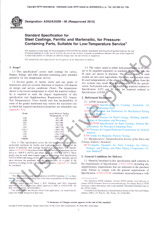We need your consent to use the individual data so that you can see information about your interests, among other things. Click "OK" to give your consent.
ASTM D7666-12(2019)
Standard Specification for Triglyceride Burner Fuel
Translate name
STANDARD published on 1.12.2019
The information about the standard:
Designation standards: ASTM D7666-12(2019)
Publication date standards: 1.12.2019
SKU: NS-978851
The number of pages: 7
Approximate weight : 21 g (0.05 lbs)
Country: American technical standard
Category: Technical standards ASTM
The category - similar standards:
Annotation of standard text ASTM D7666-12(2019) :
This specification covers two grades of burner fuel consisting of triglycerides and naturally occurring constituents of triglycerides including monoglycerides, diglycerides, and free fatty acids and distinguished by the pour point. The triglyceride burner fuels, Grade TBF5 and Grade TBF6, are intended for use in commercial or industrial air or steam-atomized fuel oil burning equipment manufactured under various climatic and operating conditions for the purposes of heat generation. This specification describes the properties and limits for triglyceride burner fuels to provide acceptable performance in liquid fuel burning equipment. It also addresses significance and use, sample collection and handling, and properties that are those of greatest significance in obtaining acceptable performance of the burner. The requirements enumerated in this specification shall be determined in accordance with the following ASTM test methods except as noted: pour point (Test Method D97), flash point (Test Method D93, Procedure B, except when other methods may be prescribed by law), water and sediment (Test Method D1796), viscosity (Test Method D445), density (Test Methods D1298, D4052, D5355, or D7042), titer (Test Method D1982), acid number (Test Method D664), ash (Test Method D482), sulfur (Test Method D4294), insolubles (Grade TBF5 and Grade TBF6) (Test Method D128, Section 12, Method 1), and heating value (heat of combustion) (Test Method D240).
Keywords:
biofuel, boiler, cooking oil, crude glycerin, fats, fatty acid, fuel, glycerin, heating fuel, industrial burner, recycled oil, rendered animal fat, TBF, triglyceride, triglyceride fuel, used fuel, used oil, used vegetable oil, vegetable oil, yellow grease,, ICS Number Code 71.080.60 (Alcohols. Ethers), 75.160.01 (Fuels in general)
Additional information
| 1. Scope | ||||||||||||||||||||||||||||||||||||||||||||||||||||||||||||||||||||||||||||||||||
|
1.1 This specification covers two grades of burner fuel consisting of triglycerides and naturally occurring constituents of triglycerides including monoglycerides, diglycerides, and free fatty acids and distinguished by the pour point. The grade designation (TBF) identifies them as triglyceride burner fuels. 1.2 The triglyceride burner fuels specified are intended for use in commercial or industrial air or steam-atomized fuel oil burning equipment manufactured from materials compatible with fuels having an acid number as specified in Table 1 and under various climatic and operating conditions for the purposes of heat generation. The fuels specified herein are not intended for blending with conventional fuel oils for this purpose. They are not intended for use in burners <0.32 GJ/h (0.3 × 106 BTU/h) such as residential burners or small pressure atomization burners nor are they intended for use in internal combustion engines or marine applications. Note 1: For information on the significance of the terminology
and test methods used in this specification, see Appendix X1.
1.3 This specification does not address the frequency with which any particular test shall be run. 1.4 Nothing in this specification shall preclude observance of national or local regulations, which can be more restrictive. 1.5 The text of this standard references notes and footnotes that provide explanatory material and shall not be considered as requirements of the standard. The table in this standard references footnotes, and these are to be considered as requirements of the standard. 1.6 The values given in SI units are to be regarded as the standard. The values given in parentheses are for information only. 1.7 This standard does not purport to address all of the safety concerns, if any, associated with its use. It is the responsibility of the user of this standard to establish appropriate safety, health, and environmental practices and determine the applicability of regulatory limitations prior to use. 1.8 This international standard was developed in accordance with internationally recognized principles on standardization established in the Decision on Principles for the Development of International Standards, Guides and Recommendations issued by the World Trade Organization Technical Barriers to Trade (TBT) Committee. |
||||||||||||||||||||||||||||||||||||||||||||||||||||||||||||||||||||||||||||||||||
| 2. Referenced Documents | ||||||||||||||||||||||||||||||||||||||||||||||||||||||||||||||||||||||||||||||||||
|
We recommend:
Technical standards updating
Do you want to make sure you use only the valid technical standards?
We can offer you a solution which will provide you a monthly overview concerning the updating of standards which you use.
Would you like to know more? Look at this page.




 Cookies
Cookies
